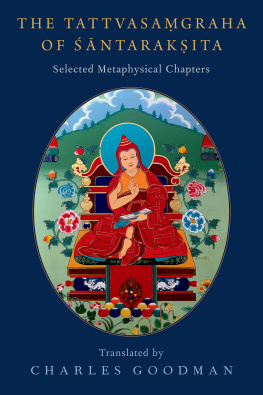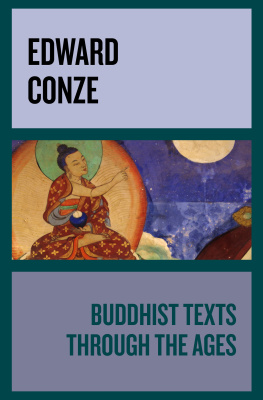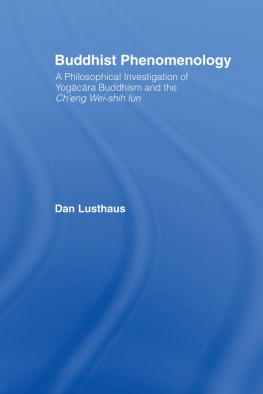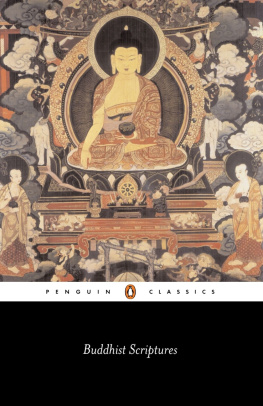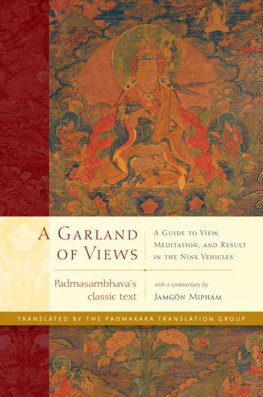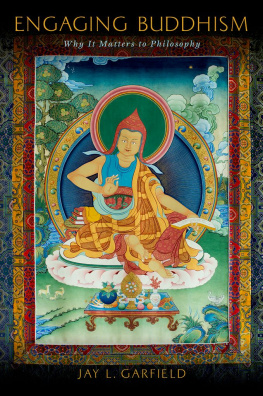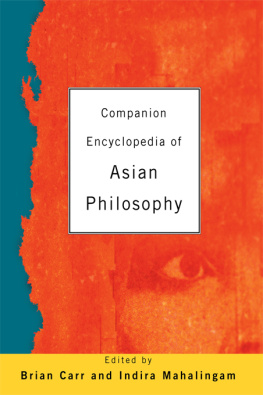The Tattvasagraha of ntarakita

Oxford University Press is a department of the University of Oxford. It furthers the Universitys objective of excellence in research, scholarship, and education by publishing worldwide. Oxford is a registered trade mark of Oxford University Press in the UK and certain other countries.
Published in the United States of America by Oxford University Press
198 Madison Avenue, New York, NY 10016, United States of America.
Oxford University Press 2022
All rights reserved. No part of this publication may be reproduced, stored in a retrieval system, or transmitted, in any form or by any means, without the prior permission in writing of Oxford University Press, or as expressly permitted by law, by license, or under terms agreed with the appropriate reproduction rights organization. Inquiries concerning reproduction outside the scope of the above should be sent to the Rights Department, Oxford University Press, at the address above.
You must not circulate this work in any other form and you must impose this same condition on any acquirer.
Library of Congress Cataloging-in-Publication Data
Names: Kamalasila, active 713763. | Goodman, Charles, 1975translator,
writer of added commentary.
Title: The Tattvasamgraha of Santaraksita / Charles Goodman.
Other titles: Tattvasangrahapanjika English.
Description: New York : Oxford University Press, 2022. |
Includes bibliographical references and index. |
Includes quotations in Sanskrit (in roman)
Identifiers: LCCN 2021011281 (print) | LCCN 2021011282 (ebook) |
ISBN 9780190927349 (hardback) | ISBN 9780190927363 (epub)
Subjects: LCSH: Santaraksita, 705762. TattvasangrahaCommentaries. |
Knowledge, Theory of (Buddhism) | Knowledge, Theory of (Hinduism) |
Indian philosophy. | Buddhist philosophy.
Classification: LCC BQ3282.E5 G66 2021 (print) | LCC BQ3282.E5 (ebook) |
DDC 181/.043dc23
LC record available at https://lccn.loc.gov/2021011281
LC ebook record available at https://lccn.loc.gov/2021011282
DOI: 10.1093/oso/9780190927349.001.0001
Contents
(Prakti-park)
(vara-park)
(Nyya-vaieika-parikalpita-tma-park)
(Mmsaka-parikalpita-tma-park)
(Kpila-parikalpita-tma-park)
(Digambara-parikalpita-tma-park)
(Aupaniadika-parikalpita-tma-park)
(Vtsputrya-parikalpita-tma-park)
(Karma-phala-sambandha-park)
Translated with Wenli Fan
(Sydvda-park)
| AK & AKBh | Abhidharma-koa and Abhidharma-koa-bhya of Vasubandhu. See Pradhan 1975, Dwrikds stri 1997-98, La Valle Poussin and Sangpo 2012, Goodman 2009. |
| EK | the Krishnamacharya edition of the TS. |
| ITD | the Illuminator Tibetan Dictionary. |
| KRPC | the Kargyud Relief and Protection Committee edition of ch. VII of the TS and TSP. |
| NBh | Nyya-bhya. See Nyaya-Tarkatirtha 1936-44. |
| NS & NV | Nyyastra and Nyyabhyavrttika. See Thakur 1997, Vidybhana 2003. |
| NTD | Ntrtha Tibetan Dictionary, published by Nitartha International at http://nitartha.org/. |
| PV | Prama-vrttika of Dharmakrti. See Pandeya 1989 |
| SD | the Dwrikds stri edition of the TS. |
| SK | Skhya-krik of varaka. See Larson 1969. |
| Bh | abarabhya of abara. See Frauwallner 1998. |
| V | loka-vrttika of Kumrila. See Jha 2009, Tailaga 1898. |
| TS | Tattvasagraha of ntarakita. |
| TSP | Tattvasagraha-pajik of Kamalala. |
This volume presents a series of translations of works by the Indian Buddhist philosopher ntarakita (c. 725788 ce) and by his student and commentator Kamalala (c. 740795 ce). The source texts are taken from an immense compilation known as the Tattvasagraha (or TS), whose title could freely be translated as the Encyclopedia of Metaphysics, and from its commentary (the Tattvasagraha-pajik, or TSP). Much of the time, the text comes off as a kind of manual or handbook for Buddhists participating in formal public debates. But its vast comprehensiveness, along with the authors tolerance for repetition and redundancy between sections, gives the unmistakable impression of a reference work; hence, encyclopedia. In at least some of the systems criticized in the text, a tattva is an ontologically real thing or sometimes a type of real things. ntarakita himself uses the word, as he indicates in the introductory material of the treatise, to refer to truths about how things in general actually are. On either interpretation, the study of tattvas would constitute what we in the West call metaphysics.
For the most part, my goal has been to allow the authors of this classic work to speak for themselves through this translation. I have tried my best to keep my use of interpretive exposition to a minimum. However, readers unfamiliar with the conventions of Buddhist epistemology may benefit from an exposition of the types of arguments found in the volume. A number of these may initially seem unfamiliar, though almost all of them have some parallel in the works of Western philosophers.
ntarakitas approach to philosophical argument is based on the system of Dharmakrti, who was perhaps the most influential figure in the whole tradition of Buddhist epistemology in India. Much uncertainty and disagreement persist about the dates of this great philosopher, although it can be definitively stated he worked between the middle of the sixth century and the middle of the seventh. But his immense impact on the South Asian philosophical landscape is generally accepted.
Digngas logic is based on the crucial concept of trairpya, a discovery whose basic formulation was not original to him but that, in his hands, was built into a persuasive and powerful system for assessing arguments. The idea is that, in order for an inference to be valid, its reason property must have three specific characteristics: the reason property (Skt. hetu or sdhana-dharma) must be present in the topic of inference; the reason must be present in at least some cases exhibiting the target property (sdhya-dharma); and the reason must be absent in every case where the target property is absent. The class of cases relevant to the second characteristic, those where the target property is present, is called the similar class (sapaka); that relevant to the third characteristic, where the target property is absent, is known as the dissimilar class (vipaka). The topic of the inference is not included in either of these classes.
To demonstrate that the reason property is present in some cases in the similar class, it is sufficient to provide a supporting example. (Normally this is called the dnta; occasionally, as in TS 189, it is referred to as the illustration, Skt. nidarana.) Sometimes a dissimilar example will also be presented; this is a case in which the reason property and the target property are both absent.
It will be evident that the basic structure of this approach to logic is somewhat different from that of the system of Aristotelian syllogisms. A paradigm example of the latter would be

